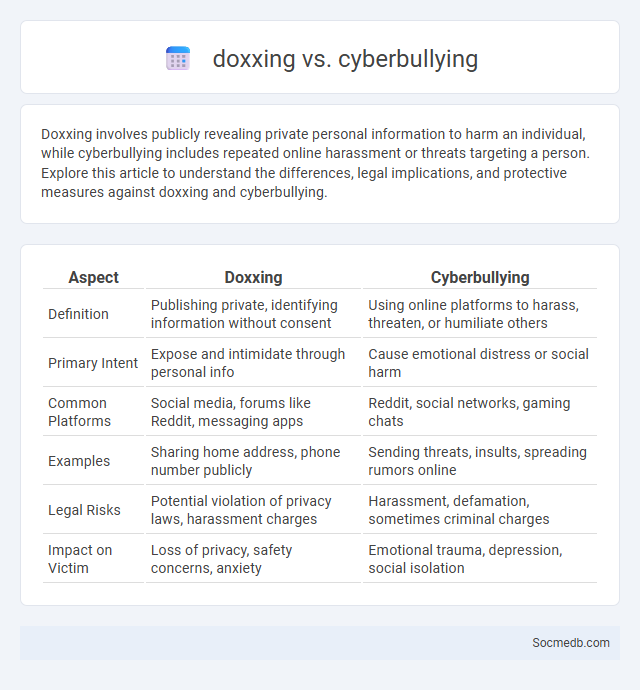
Photo illustration: doxxing vs cyberbullying
Doxxing involves publicly revealing private personal information to harm an individual, while cyberbullying includes repeated online harassment or threats targeting a person. Explore this article to understand the differences, legal implications, and protective measures against doxxing and cyberbullying.
Table of Comparison
| Aspect | Doxxing | Cyberbullying |
|---|---|---|
| Definition | Publishing private, identifying information without consent | Using online platforms to harass, threaten, or humiliate others |
| Primary Intent | Expose and intimidate through personal info | Cause emotional distress or social harm |
| Common Platforms | Social media, forums like Reddit, messaging apps | Reddit, social networks, gaming chats |
| Examples | Sharing home address, phone number publicly | Sending threats, insults, spreading rumors online |
| Legal Risks | Potential violation of privacy laws, harassment charges | Harassment, defamation, sometimes criminal charges |
| Impact on Victim | Loss of privacy, safety concerns, anxiety | Emotional trauma, depression, social isolation |
Introduction to Online Harassment
Online harassment involves the use of digital platforms such as social media, forums, and messaging apps to target individuals with abusive, threatening, or harmful behavior. Common forms include cyberbullying, trolling, doxing, and hate speech, which can severely impact victims' mental health and online participation. Understanding the mechanisms and consequences of online harassment is essential for developing effective prevention and response strategies.
Defining Doxxing: Exposure of Personal Information
Doxxing involves the intentional exposure of an individual's personal information, such as home addresses, phone numbers, or private communications, often without consent. This practice poses significant privacy risks and can lead to harassment, identity theft, or physical harm. Social media platforms are frequently targeted for doxxing due to the vast amount of personal data users share online.
What is Cyberbullying?
Cyberbullying involves the use of digital platforms such as social media, messaging apps, and online forums to harass, threaten, or humiliate individuals. It includes actions like spreading false information, sending threatening messages, sharing private content without consent, and creating harmful online personas. This behavior negatively impacts victims' mental health, often leading to anxiety, depression, and in severe cases, suicidal thoughts.
Personal Information Doxxing Explained
Personal information doxxing involves the malicious act of publishing private data, such as addresses, phone numbers, or financial details, on social media platforms without consent. This practice exposes individuals to identity theft, harassment, and privacy violations, posing severe risks in digital environments. Strengthening privacy settings and employing digital security tools are critical measures to protect against doxxing on social media.
Key Differences Between Doxxing and Cyberbullying
Doxxing involves publicly revealing private or identifying information about an individual online without their consent, often leading to harassment or physical danger. Cyberbullying encompasses a broader range of aggressive behaviors conducted through digital platforms, including threats, insults, and spreading false information intended to intimidate or harm the victim emotionally. The primary distinction lies in doxxing's focus on exposing personal data, while cyberbullying targets psychological abuse through repeated hostile actions.
Overlapping Risks: Doxxing in Cyberbullying
Doxxing poses a significant overlapping risk in cyberbullying by exposing Your personal information to malicious actors, increasing the threat of harassment and identity theft. This breach of privacy can escalate cyberbullying incidents, leading to severe emotional and reputational damage. Protecting sensitive data on social media platforms is crucial to minimizing these intersecting dangers.
Legal Perspectives: Laws on Doxxing and Cyberbullying
Laws on doxxing and cyberbullying vary globally, with many jurisdictions criminalizing the malicious sharing of personal information and online harassment to protect individuals' privacy and safety. In the United States, statutes like the Cyberstalking Prevention Act and various state-level laws impose penalties for doxxing and cyberbullying, emphasizing harm to victims' mental well-being. European countries enforce the General Data Protection Regulation (GDPR) alongside specific cyber abuse laws, ensuring strict accountability for digital offenses involving personal data misuse and online harassment.
Emotional and Social Impact on Victims
Social media platforms significantly influence the emotional and social well-being of victims by amplifying feelings of isolation, anxiety, and depression through cyberbullying and online harassment. Persistent negative interactions online can lead to long-term psychological trauma and reduced self-esteem, impacting victims' daily functioning and social relationships. Support networks formed on social media offer some relief, yet the pervasive exposure to harmful content often exacerbates emotional distress among vulnerable individuals.
Prevention and Protection Strategies
Effective prevention and protection strategies on social media include enabling strong privacy settings and regularly updating passwords to safeguard your personal information from cyber threats. Monitoring your digital footprint and being cautious about sharing sensitive content can minimize the risk of identity theft and online harassment. Employing two-factor authentication and frequently reviewing app permissions further strengthens your social media security.
Conclusion: Navigating Internet Safety
Navigating internet safety requires understanding key risks such as phishing, malware, and data breaches to protect your personal information on social media platforms. Employing strong passwords, enabling two-factor authentication, and adjusting privacy settings can significantly reduce vulnerability to cyber threats. Staying informed about emerging online scams empowers you to maintain control over your digital security and social media experience.
 socmedb.com
socmedb.com